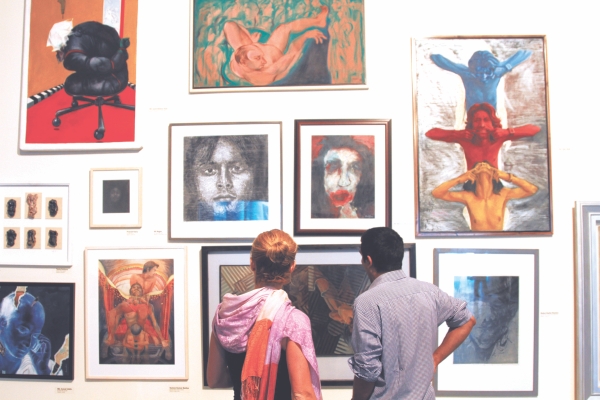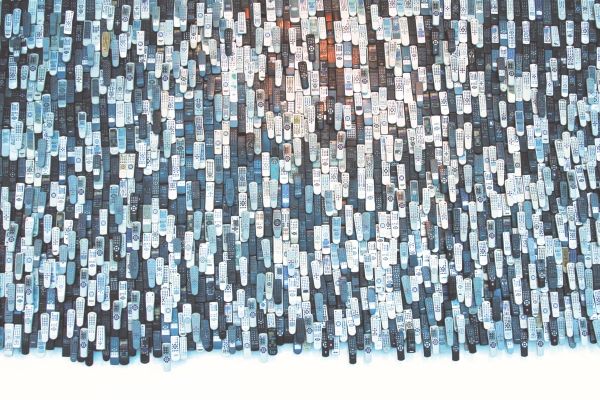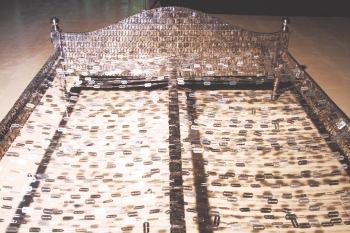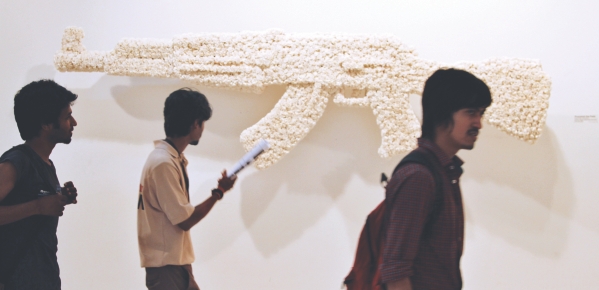| Home - Back Issues - The Team - Contact Us |
 |
| Volume 11 |Issue 16 | April 20, 2012 | |
|
|
Special Feature ART GOING GLOBAL The Dhaka Art Summit 2012 introduces Bangladeshi art to the international art community Anika Hossain Being a full time artist is probably one of the most challenging choice of career, especially in a country where the trend of patronizing art has surfaced fairly recently. Bangladeshi artists have struggled for many years for recognition and appreciation but only a notable few have actually made it in the art scene of this country, and fewer still, have had their work internationally recognised for their excellence.
Names such as Zainul Abedin, Quamrul Hassan, Qayyum Chowdhury and Syed Jahangir come to mind when prominent Bangladeshi artists are mentioned, but very few people know about the hundreds of artists, especially from the current generation who emerge with commendable work, just waiting to be discovered. Rajeeb and Nadia Samdani, founders of the Samdani Art Foundation (SAF) noticed this need for discovery and decided to extend a helping hand to these gifted artists. “We noticed, that virtually no Bangladeshi art is seen at art fairs, museums, private collections etc abroad and we decided to do something about it,” says Nadia Samdani, the CEO of SAF. The SAF, in collaboration with Bangladesh National Museum and Bangladesh Shilpakala Academy organised the Dhaka Art Summit, a 4 day (April 12-15) event which aimed to provide an interesting new platform for avant-garde artists in the Bangladeshi art community. “We want to promote Bangladeshi artists both locally and internationally,” says Nadia Samdani. The Summit featured 249 artists, and held exhibitions in 19 galleries in Dhaka, including the Bengal Gallery of Fine Arts, Britto Arts Trust, Tivoli Art Gallery, Dhaka Art Centre, Drik Gallery, Gallery ChitrakGallery, Jolrong, Galleri Kaya, Haque Art Gallery, Gallery Cosmos, Porapara Space for Artists, Radius Centre, Saju Art Gallery, Bengal Art Lounge, Santaran Art Organisation and Interior Depot. The artwork was judged by an international jury consisting of well known art critics, historians, curators and painters from all over the world. Among these prestigious guests were Kyla McDonald, curator of Tate Modern Museum in England, Dr Deepak Ananth, art historian and expert from France, Elaine W Ng, editor and publisher of Art Asia Pacific, Indian artist and Ravinder Reddy who were on the jury panel along with Bangladeshi painter Shahabuddin Ahmed. Among other distinguished international guests were, Neha Kirpal, director of India Art Summit, Dr Amin Jaffer, International Director of Asian Art at Christie's, Dr Deepanjana Klein, chief of Modern and Contemporary South Asian Art Department, Yamini Mehta, specialist and head of Modern and Contemporary Indian Art of Christie's. “A lot of prominent people in the art world have come all the way here to see the Bangladeshi art scene,” says Nadia Samdani, “Famous critics and international journalists will be observing the work of these artists. If they like the work of even one artist and write about it, I believe it will be hugely beneficial and the summit will have been successful.” According to Samdani, the international guests were impressed by the displays at the exhibitions. “They seem very pleased and have said they will be coming back for another visit very soon. There was a lot of interest in the young artists, their language, medium, the subjects they are using and why. A lot of interest has been generated through this summit in this part of the world,” she comments.
“The Dhaka Art Summit has been very exciting and it's a great start for the future development of Bangladeshi art,” says Kyla Mc Donald, curator of Tate Modern Museum in England. “I've seen the work of experienced artists and seen great energy, passion and enthusiasm in the work of the younger artists. I think this is a great platform for them to display their talents and I see a bright future ahead for them,” she comments. Yamini Mehta, specialist and head of Modern and Contemporary Indian Art of Christie's agrees, “My colleagues and I were really thrilled to come and investigate the art scene in Bangladesh,” she says. “We are familiar with Indian and Pakistani art but we have not seen Bangladeshi art in the international scene. We were duly impressed by the talent of the artists as well as the organisation of this event. It is exciting to see a flourish in contemporary art in this country and see the modernist themes in the displays. Hopefully, we will see some of these talented artists in the international art scene in the next 5 to 10 years.” The participating artists displayed works created from a variety of mediums including oil, acrylic, watercolour, glass, ceramic, cardboard, wood, and prints from etching, aqua tint, linoleum, lithograph, serigraph, woodcuts etc. The displays also included installation, video art, videography, photography, sculpture and other mixed mediums.
While the experienced artists never fail to impress with their masterpieces, the younger generation produced work that was bright, bold and aggressive. They thought out of the box and used new types of medium creating dramatic effects. Abdus Salam's work with cardboard packaging boxes and paper bags was innovative and eye catching with its vibrant colours and subjects from popular Dhaliwood movies and advertisements. Fahmida Enam Kakoli's work with the traditional nakshi kantha was also vibrant and exciting. Shumon Ahmed's photographs intrigued the viewers with their choice of subject and display of emotions.
Nityananda Gaine's etching “Waiting for Journey,” depicting a group of people waiting at the bus stop emanated the frustration and exhaustion of commuters in the city. Najib Tarek's ball point on paper, “Harano Sonlap,” was equally fascinating and lively. Titu Deb Nath's chromatic oil painting “Trying to Smile,” portraying a youngster in his efforts to force an emotion, enamoured the viewers, while Sharif Ahmed's ceramic sculpture “Waiting,” left them with a feeling of loss and emptiness. “I think the biggest achievement of the summit is that it brought many organisations and galleries promoting art on one platform,” says Mahbubur Rahman, a participating artist, “This means that there will be a dialogue between them and they may work together in the future, which will be beneficial for the artists they sponsor. In this exhibition we identified artwork from different times and we could see the development of art in Bangladesh over the years. Every artist must embark on a journey to gather the experience needed to bring about maturity in their work and I believe this is a great start for them. I think is fantastic that the international community has been introduced to our art through this summit,” he opines. Monirul Islam, who has made a name in Spain's art scene and whose work was also displayed at the summit says, “30 to 40 years ago, there was virtually no local market for art. Nowadays people are beginning to appreciate art more and have the means to purchase, even collect artwork, so the local demand has increased considerably. What we need now, is to make our art known internationally and that is where this summit will help.” According to Islam, local galleries need to increase their standards and have financial back up in order to participate in art fairs and exhibitions abroad. “India has a large local market for art, they have not shown interest in our work,” says Islam, “As for Europe and America, they are going through an economic crisis, so they won't be able to spare much finances for our art work. Back in the day, kings used to commission artists in his court for their work and four to five hundred years later that hasn't changed. The only difference is that kings have been replaced by bankers and business tycoons and artists have more freedom to choose their subjects. We need more patrons to back us up financially so we can enter the international art scene on our own. Each country has its own major art fair and we must follow their example to promote ourselves,” he comments.
Islam notices the effect of globalisation on the work of the younger generation of artists. “The youngsters have access to the internet, which is exposing them to newer levels of art and opening up their horizons,” he says. “They are being introduced to new ideas and materials and I am fascinated to see installations, video art and other modern art techniques. I still believe we should hold on to our identity as Bangladeshis and incorporate a part of us into our art. Young generations are conscious of this too.” At the end of the event, SAF presented two awards, the Samdani Artist Development Award of Tk 10 lakh and Samdani Young Talent Award which was Tk 5 lakh. This financial support, as well as exposure to art connoisseurs, critics and artists from all over the world who were raving about their work gave our artists the confidence boost that they needed to move forward and do more extraordinary things in the future. “We plan to organise another summit in January 2014,” says Nadia Samdani. “We will be inviting foreign artists and international galleries to participate as well.” Hopefully, this is a start of a brand new era of exciting contemporary art, which will flourish with support and appreciation both at home and abroad. Copyright
(R) thedailystar.net 2012 |
||||||||




